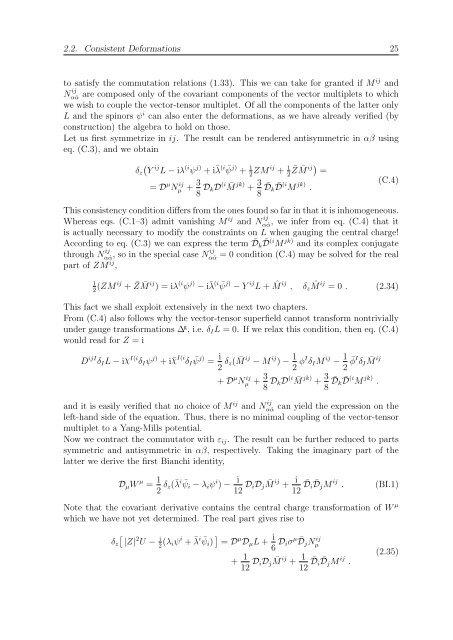N=2 Supersymmetric Gauge Theories with Nonpolynomial Interactions
N=2 Supersymmetric Gauge Theories with Nonpolynomial Interactions
N=2 Supersymmetric Gauge Theories with Nonpolynomial Interactions
Create successful ePaper yourself
Turn your PDF publications into a flip-book with our unique Google optimized e-Paper software.
2.2. Consistent Deformations 25<br />
to satisfy the commutation relations (1.33). This we can take for granted if M ij and<br />
N ij<br />
α ˙α are composed only of the covariant components of the vector multiplets to which<br />
we wish to couple the vector-tensor multiplet. Of all the components of the latter only<br />
L and the spinors ψi can also enter the deformations, as we have already verified (by<br />
construction) the algebra to hold on those.<br />
Let us first symmetrize in ij. The result can be rendered antisymmetric in αβ using<br />
eq. (C.3), and we obtain<br />
ij (i j)<br />
δz Y L − iλ ψ + iλ ¯(i ψ¯ j) 1 + 2ZM ij + 1<br />
2 ¯ Z ¯ M ij =<br />
= D µ N ij<br />
µ + 3<br />
8 DkD (i M¯ jk) 3<br />
+<br />
8 ¯ Dk ¯ D (i M jk) .<br />
(C.4)<br />
This consistency condition differs from the ones found so far in that it is inhomogeneous.<br />
Whereas eqs. (C.1–3) admit vanishing M ij and N ij<br />
α ˙α , we infer from eq. (C.4) that it<br />
is actually necessary to modify the constraints on L when gauging the central charge!<br />
According to eq. (C.3) we can express the term ¯ Dk ¯ D (iM jk) and its complex conjugate<br />
through N ij<br />
ij<br />
α ˙α , so in the special case Nα ˙α = 0 condition (C.4) may be solved for the real<br />
part of ZM ij ,<br />
1<br />
2 (ZM ij + ¯ Z ¯ M ij ) = iλ (i ψ j) − i¯ λ (i ψ¯ j) ij<br />
− Y L + Mˆ ij<br />
, δz ˆ M ij = 0 . (2.34)<br />
This fact we shall exploit extensively in the next two chapters.<br />
From (C.4) also follows why the vector-tensor superfield cannot transform nontrivially<br />
under gauge transformations ∆ g , i.e. δIL = 0. If we relax this condition, then eq. (C.4)<br />
would read for Z = i<br />
D ijI δIL − iχ I(i δIψ j) + i¯χ I(i δI ¯ ψ j) = i<br />
2 δz( ¯ M ij − M ij ) − 1<br />
2 φI δIM ij − 1<br />
2 ¯ φ I δI ¯ M ij<br />
+ D µ N ij<br />
µ + 3<br />
8 DkD (i ¯ M jk) + 3<br />
8 ¯ Dk ¯ D (i M jk) .<br />
and it is easily verified that no choice of M ij and N ij<br />
α ˙α can yield the expression on the<br />
left-hand side of the equation. Thus, there is no minimal coupling of the vector-tensor<br />
multiplet to a Yang-Mills potential.<br />
Now we contract the commutator <strong>with</strong> εij. The result can be further reduced to parts<br />
symmetric and antisymmetric in αβ, respectively. Taking the imaginary part of the<br />
latter we derive the first Bianchi identity,<br />
DµW µ = 1<br />
2 δz( ¯ λ i ¯ ψi − λiψ i ) − i<br />
12 DiDj ¯ M ij + i<br />
12 ¯ Di ¯ DjM ij . (BI.1)<br />
Note that the covariant derivative contains the central charge transformation of W µ<br />
which we have not yet determined. The real part gives rise to<br />
2 i<br />
δz |Z| U − 2 (λiψ i + ¯ λ i ψi) ¯ = D µ DµL + i<br />
6 Diσ µ DjN ¯ ij<br />
µ<br />
+ 1<br />
12 DiDj ¯ M ij + 1<br />
12 ¯ Di ¯ DjM ij .<br />
(2.35)

















